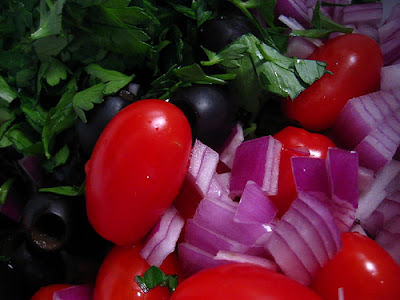That's just a bit too many.
I thought I'd help bring some order to the granola universe out there, and so I've put together a linkfest of what I consider to be exceptional granola recipes. Some of these recipes come from food sites and blogs I know and trust, other recipes caught my eye because they were particularly creative or original. I have looked over each and every one of these recipes with a critical eye for quality.
In general, a good granola recipe shouldn't be too sugary (we're making granola here, not candy), nor should it contain too much salt (in that case you might as well buy industrially-made granola at the store). The recipe should be relatively easy to make, and it shouldn't break the bank--after all, this is Casual Kitchen.
Some of these recipes contain creative, even obscure, ingredients, but the vast majority of them are totally straightforward. My goal was to have all of these recipes pass at least some of the five easy questions, so they should all be fairly easy for you to make in your own kitchen.
This exercise was surprisingly fun, and best of all, it gave me some great ideas for variations on my own granola recipe. I hope you find it helpful!
And of course, feel free to chime in down in the comments section if you have any favorite granola recipes you'd like to share.
**********************************
Homesick Texan: Uncle Austin's Granola
Once again, Homesick Texan gets it done with this one. Simple and straightforward, with an emphasis on coconut flakes. One of the amusing alternate names for this recipe is “Health Camp Hi-Carb Granola: Preferred by Nudists Everywhere.” It must be good with that kind of endorsement.
Chunky Date, Coconut and Almond Granola from Epicurious
I think I'd double this recipe right off the bat. Contains cashews and dates.
Jennifer's Granola from Allrecipes
The flax seed in this recipe will give you a healthy dose of omega-6 and omega-3 oils, and the wheat germ will give you a healthy dose of protein. One especially useful feature in Allrecipes is the convenient buttons for converting to metric or for scaling up the recipe.
Homemade Granola by Stephanie Jaworski
At joyofbaking.com. This recipe is sweetened with maple syrup, also contains a lot of useful suggestions for modifications.
A Granola Recipe from My Mom's Hippie Youth
At slashfood.com. Marisa McClellan shares a granola recipe from 1970's San Francisco with sesame seeds, sunflower seeds and coconut. When you Google granola or any related terms, this will likely be one of the very first results. It deserves to be there.
Smitten Kitchen's Granola Recipe, adapted from Calle Ocho
SK's recipe starts off with a pumpkin butter recipe which looks interesting, but if you want to get right to the granola recipe, just scroll about 1/3 of the way down the page.
Even the New York Times has a granola recipe
What's most surprising to me is how unpretentious this recipe is.
Pam Anderson's granola recipe in the USA Today
No, it's not that Pam Anderson. Contains eight variations on the main recipe. Try #3: Granola with Tropical Flavoring. Also contains useful advice on making granola clusters: "to help the cereal cluster, add a smidgen of water. In combination with the oil and liquid sweetener, the water mixes with the wheat germ to create a delicious mortar." Mmmmm... mortar.
Mix and Match Granola from The Prepared Pantry
What's intriguing about this recipe is that it calls for any combination of rolled oats, wheat, or barley as the base of the mix.
Going Raw's Raw Granola
A shout-out to any of you who are interested in a raw-only version of granola. Although if you ask me, it's a slippery slope using a dehydrator and still calling your recipe "raw." You'll probably have to make some substitutions here for some of the more difficult to find ingredients.
Pistachio Granola from fruitandveggieguru.com
Naturally, this recipe comes from a large pistachio producer, Paramount Farms. But I like the fact that this recipe uses apple juice instead of oil to hold itself together.
This recipe contains whole wheat flour and millet. Very interesting. Also with several suggested variations.
FitFam.com's Quick and Simple Granola Recipe
Really, really easy to make. Although I have to admit I don't know what "Earth Balance Spread" is. I think I'll stick with canola oil.
A delicious and quick granola recipe with no oil added
From Dee's Cereal. Also be sure to check out his Popcorn Granola--I never thought of adding popcorn to granola, what a great idea!
Crunchy Granola from the Culinate Kitchen recipe collection We've got everything but the kitchen sink in this recipe. Contains wheat germ and bran plus different nuts and dried fruit. Fairly low oil content.
Rancho La Puerta Granola, courtesy of Orangette
Another granola recipe with de minimus oil. The orange zest and small amount of orange juice in this recipe seem fitting somehow... I'm not sure why.
Allrecipes' Stovetop Granola
Another granola recipe from Allrecipes, but this one doesn't require any oven time. Thus it likely has the shortest preparation time of all the recipes in this list.
Justin Trails Resort's Award Winning Granola Recipe
Unfortunately it doesn't specify exactly what award it won, but the recipe caught my eye because it contains peanut butter, a creative idea for a "fixer" to hold the granola together. Justin Trails is a bed and breakfast in Sparta, Wisconsin.
Related Posts:
Casual Kitchen's An Easy Granola Recipe
How to Modify a Recipe: Granola Before and After
15 Creative Tips to Avoid Holiday Overeating
41 Ways You Can Help the Environment From Your Kitchen
How can I support Casual Kitchen?
If you enjoy reading Casual Kitchen, tell a friend and spread the word! You can also support me by linking to me, subscribing to my RSS feed, or submitting this article, or any other article you particularly enjoyed here, to bookmarking sites like del.icio.us, digg or stumbleupon.










